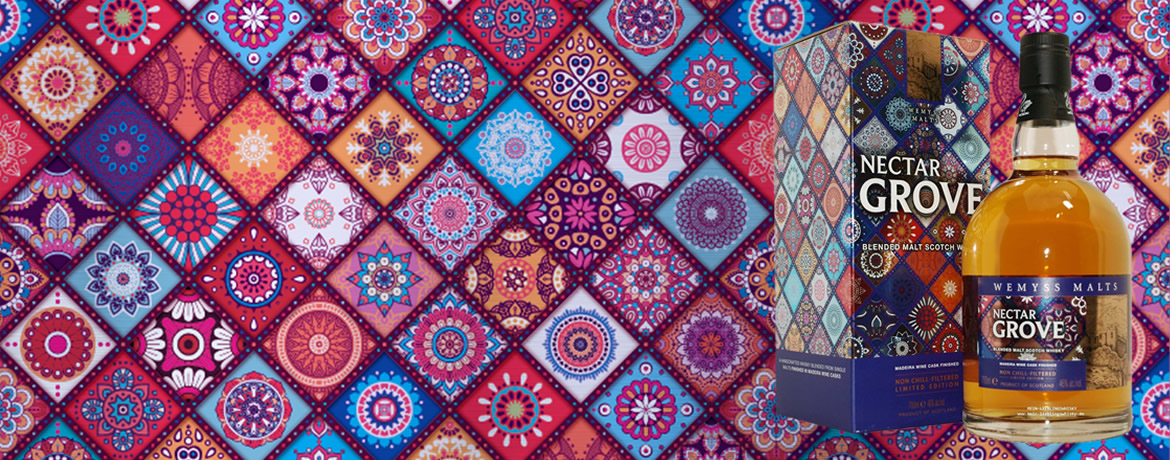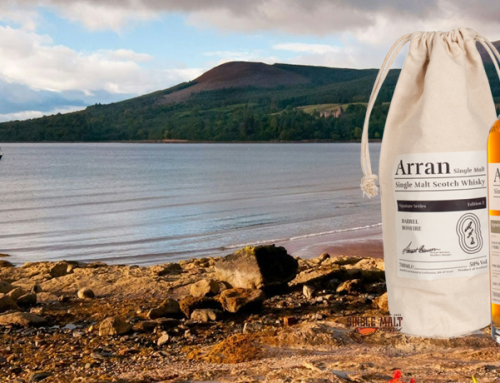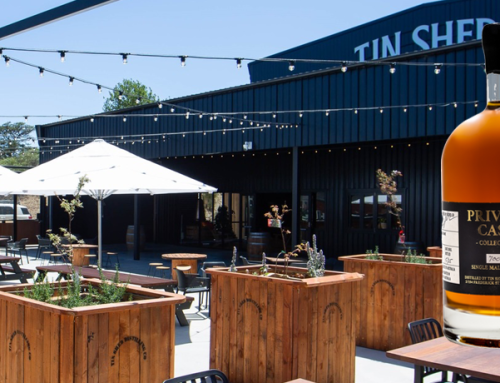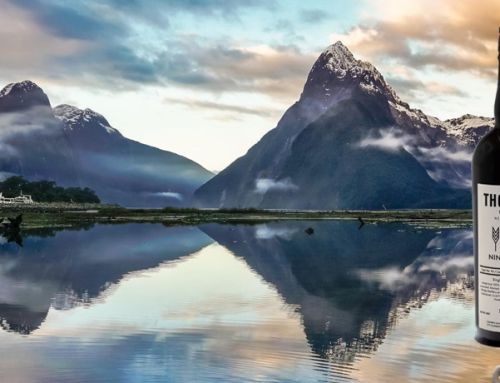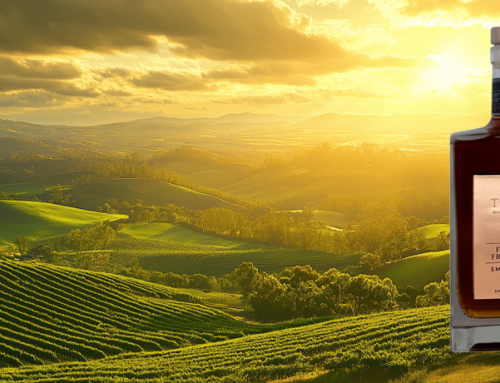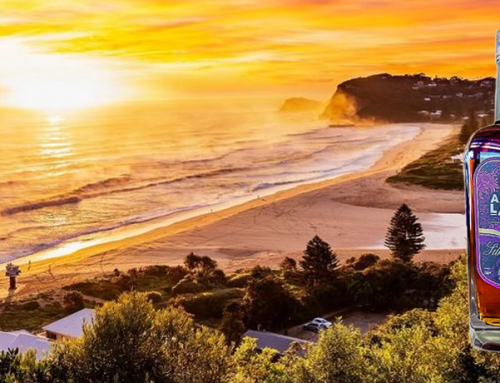For July we have something completely different. Well, not completely different, but at the very least something we seldom offer – a vatted malt. A limited edition (9000 bottles only), and we are the first in Australia to be trying it! Introducing Wemyss Malts Nectar Grove. It’s fresh off the boat and the first bottle in Oz has just made it to my place for this review! #FIRST!
The Nectar Grove expression is a limited edition (9000 bottles only) and has been blended from non-peated Highland malts. The exact distilleries whose malts are utilised are a tight kept secret. We can reveal that these malts were specifically selected for their high ester (fruity flavours) content with the aim of blending a sweet, fruit-driven whisky (hence the Nectar Grove name).
The new make spirits were then matured initially in refill bourbon casks. According to Wemyss Brand Ambassador Steven Shand, this part of the maturation was to “…give an even maturation that focused more or mellowing the spirit and removing impurities rather than adding intense wood lead tannins, the likes of which you usually see in 1st and 2nd fill casks”.
Ages of whiskies in this initial maturation range between 5 and 10 years in order to “… layer flavours that are unveiled at lengths of time in cask maturation”. Steven uses the example of esters that give ‘fruity’ notes in young whisky that slowly fade over time in a cask to give way to the tannins, vanillins and lactones from the wood.
After this initial maturation, the single malts are ‘married’ together into ex-madeira wine casks for around 9 months to ‘finish’. This stage of the maturation aims to impart yet more sweet fruity notes from the madeira cask.
So… what does it taste like?
The nose isn’t massive but has a very floral quality at first. This gives way to peaches, apricots and squeezed orange peel with a buttery undertone of condensed milk from a tube.
Very crisp mouthfeel – not at all oily and slightly astringent at first. Oranges, peaches and stonefruit, mixed peel which moves over to allow the candied fruit and barley sugar to move into position. Absolutely no peat here at all – it’s all about the esters!
The finish builds to a clean, spicy oak hit with not as much fruit as I expected but more of a baking fruit-bun quality. Nice vanilla overtones as it fades out into caramalised posterity.
Overall, a very nice, clean, whisky with some American oak ‘cheek sucking’ astringency – but the fruit on the palate sweetens the deal considerably. For those that love their whisky on the ‘lighter’ side (not oily or peaty), but still heaps of flavour – this is for you!
Nectar Grove is a fantastic ‘introduction to malt whisky’ for first timers as it’s sweet and fruity, and not going to scare them away with a huge alcohol hit nor peat-fire smokiness. Experienced drammers will enjoy the ‘punch’ (though not excessive) that the 46% ABV gives the many fruit flavours that come through and seem to morph at each subsequent sip.
NECTAR GROVE – DISTILLERS NOTES
ABV: 46%
Bottle Size: 700ml
Region: Scotland
Peated: No
Colour: Nectarine Gold
Nose: Intoxicating aromas of floral hibiscus and camomilewith a fruity charisma of orange oil, apricot and a freshly opened tin of peaches entwined with milk chocolate, honeyed granola and freshly baked Pastal de Nata (Portuguese sweet egg tarts.)
Palate: An extra maturation in Madeira wine casks imparts this highland whisky with flavours as juicy and fruity as a ready to harvest fruit grove. Sweet citrus fruit notes of nectarine, peach, and candied orange peel build to deeper notes of spun sugar caramel, baklava and hazelnut spread.
Finish: The lingering oak wood spice, sweet pastry and soft stone fruit notes remind us of a Mediterranean market brimming with fresh fruit and bakery stalls.
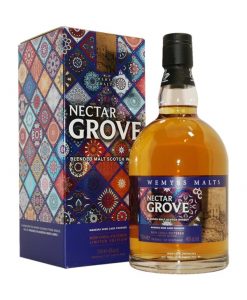
ABOUT THE DISTILLERY
Wemyss Malts (pronounced ‘Weems’) are independent bottlers. The family has been involved in the whisky industry for well over a hundred years. In fact John Haig set up his first distillery (Cameron Bridge Distillery – still in production but solely grain alcohol production only these days) on Wemyss family land. Historically, Wemyss role in the industry has been barley production, with a move into independent bottling a relatively recent direction (2005). Whilst they do produce single cask malts, Wemyss are becoming more and more well known for their blended malts. Interestingly, they name their whiskies for the flavour profiles showcased by each expression. Names such as “Frosted Molasses”, “Gingerbread House”, “Vanilla Burst” and “Spice King” are favoured over the names of the distilleries whose malts make up the whisky. In fact Weymss remains very tightly ‘mum’ on the subject of whose malts go into their blended malts.

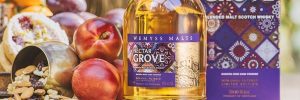
Ok, so the Nectar Grove is a vatted malt – or as Wemyss Malts and ‘the Whisky Industry’ now call it, a ‘blended malt’. So what is a ‘blended malt’ (or ‘vatted malt’ in the old vernacular)? Well firstly it is 100% malt whisky. Lets get that out of the way right at the start. Unlike a ‘Blended Scotch’ (which are typically around 70% grain alcohol), a ‘Blended Malt’ is completely unsullied by any spirit other than malt whisky from copper pot stills. So – just as a non-single cask single malt is a blend of different casks from the same distillery, a blended malt is blend of casks from different malt whisky distilleries.
The fact is, blended malts are having somewhat of a surge in popularity with lots of well established brands moving to add a blended malt expression to their portfolios. Monkey Shoulder has been making big waves since 2005 now. Chivas have recently launched their Chivas Ultis, Johnnie Walker have reintroduced their Green Label and added a peated blended malt – the Island Green to their line-up. Even Famous Grouse have gotten onboard the blended malt bandwagon and released their Naked Grouse expression as well as Buchanans with their Buchanan’s Select 15yo.
So what do blended malts bring to the table that single malts don’t? Well, primarily they offer the blenders a whole new palette from which to draw their desired flavour profiles. They also allow younger malts to be blended together to smooth out the youthful flavour indiscretions. As younger whiskies are generally cheaper whiskies – the cost benefit of being able to use younger whiskies is immediately obvious.
